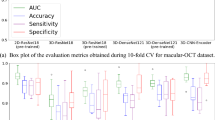Abstract
Optical Coherence Tomography (OCT) imaging plays an important role in glaucoma diagnosis in clinical practice. Early detection and timely treatment can prevent glaucoma patients from permanent vision loss. However, only a dearth of automated methods has been developed based on OCT images for glaucoma study. In this paper, we present a novel framework to effectively classify glaucoma OCT images from normal ones. A semi-supervised learning strategy with smoothness assumption is applied for surrogate assignment of missing function regression labels. Besides, the proposed multi-task learning network is capable of exploring the structure and function relationship from the OCT image and visual field measurement simultaneously, which contributes to classification performance boosting. Essentially, we are the first to unify the structure analysis and function regression for glaucoma screening. It is also worth noting that we build the largest glaucoma OCT image dataset involving 4877 volumes to develop and evaluate the proposed method. Extensive experiments demonstrate that our framework outperforms the baseline methods and two glaucoma experts by a large margin, achieving 93.2%, 93.2% and 97.8% on accuracy, F1 score and AUC, respectively.
Access this chapter
Tax calculation will be finalised at checkout
Purchases are for personal use only
Similar content being viewed by others
References
Jonas, J.B., Aung, T., Bourne, R.R., Bron, A.M., Ritch, R., Panda-Jonas, S.: Glaucoma. Lancet 390, 2183–2193 (2017)
Huang, M.-L., Chen, H.-Y.: Development and comparison of automated classifiers for glaucoma diagnosis using stratus optical coherence tomography. Invest. Ophthalmol. Vis. Sci. 46(11), 4121–4129 (2005)
Kim, H.J., Lee, S.-Y., Park, K.H., Kim, D.M., Jeoung, J.W.: Glaucoma diagnostic ability of layer-by-layer segmented ganglion cell complex by spectral-domain optical coherence tomography. Invest. Ophthalmol. Vis. Sci. 57(11), 4799–4805 (2016)
Christopher, M., et al.: Retinal nerve fiber layer features identified by unsupervised machine learning on optical coherence tomography scans predict glaucoma progression. Invest. Ophthalmol. Vis. Sci. 59(7), 2748–2756 (2018)
Ramzan, A., Akram, M.U., Shaukat, A., Khawaja, S.G., Yasin, U.U., Butt, W.H.: Automated glaucoma detection using retinal layers segmentation and optic cup-to-disc ratio in optical coherence tomography images. IET Image Processing 13, 409–420 (2018)
Maetschke, S., Antony, B., Ishikawa, H., Garvani, R.: A feature agnostic approach for glaucoma detection in OCT volumes, arXiv preprint arXiv:1807.04855 (2018)
El Beltagi, T.A., et al.: Retinal nerve fiber layer thickness measured with optical coherence tomography is related to visual function in glaucomatous eyes. Ophthalmology 110(11), 2185–2191 (2003)
Leite, M.T., Zangwill, L.M., Weinreb, R.N., Rao, H.L., Alencar, L.M., Medeiros, F.A.: Structure-function relationships using the Cirrus spectral domain optical coherence tomograph and standard automated perimetry. J. Glaucoma 21(1), 49 (2012)
Chapelle, O., Scholkopf, B., Zien, A.: Semi-supervised learning (chapelle, o. et al., eds.; 2006)[book reviews]. IEEE Trans. Neural Netw. 20(3), 542 (2009)
He, K., Zhang, X., Ren, S., Sun, J.: Deep residual learning for image recognition. In: Proceedings of the IEEE Conference on Computer Vision and Pattern Recognition, pp. 770–778 (2016)
Wang, X., et al.: Weakly supervised learning for whole slide lung cancer image classification. In: Medical Imaging with Deep Learning (2018)
Zhou, B., Khosla, A., Lapedriza, A., Oliva, A., Torralba, A.: Learning deep features for discriminative localization. In: Proceedings of the IEEE Conference on Computer Vision and Pattern Recognition, pp. 2921–2929 (2016)
Acknowledgements
This project is supported in part by the National Basic Program of China 973 Program under Grant 2015CB351706, grants from the National Natural Science Foundation of China with Project No. U1613219, Research Grants Council - General Research Fund, Hong Kong (Ref: 14102418) and Shenzhen Science and Technology Program (No. JCYJ20180507182410327).
Author information
Authors and Affiliations
Corresponding author
Editor information
Editors and Affiliations
Rights and permissions
Copyright information
© 2019 Springer Nature Switzerland AG
About this paper
Cite this paper
Wang, X. et al. (2019). Unifying Structure Analysis and Surrogate-Driven Function Regression for Glaucoma OCT Image Screening. In: Shen, D., et al. Medical Image Computing and Computer Assisted Intervention – MICCAI 2019. MICCAI 2019. Lecture Notes in Computer Science(), vol 11764. Springer, Cham. https://doi.org/10.1007/978-3-030-32239-7_5
Download citation
DOI: https://doi.org/10.1007/978-3-030-32239-7_5
Published:
Publisher Name: Springer, Cham
Print ISBN: 978-3-030-32238-0
Online ISBN: 978-3-030-32239-7
eBook Packages: Computer ScienceComputer Science (R0)





